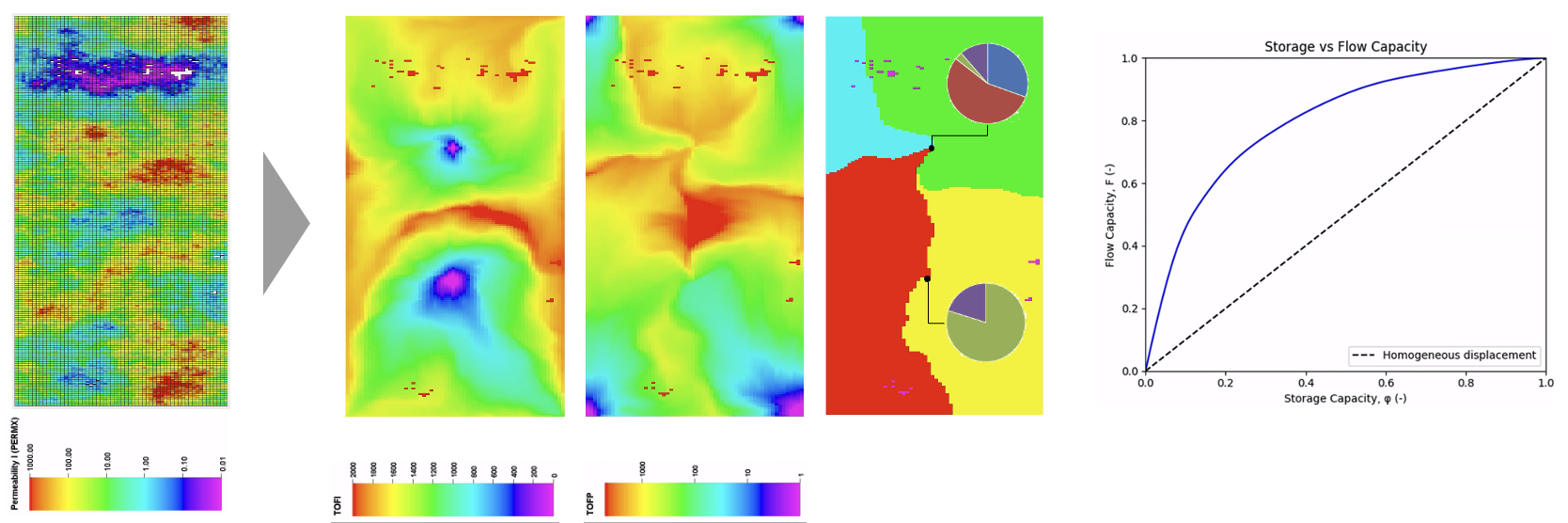Usage#
Prerequisites#
Before running, ensure that you have completed a reservoir simulation and that the output includes all necessary data for flow diagnostics. This should include pore volume, fluxes, cell connections, and well information, stored in the binary output files.
For SLB simulators (or OPM): ensure that you generate
.INITand.EGRIDfiles. Additionally, specifyFLORESunderRPTPSTkeyword to output fluxes in reservoir conditions. Alternatively, the tool also works if both fluxes in surface conditions and formation volume factors are available.For CMG simulators: Use
FLUXCONalong withOUTSRFkeyword to output fluxes in reservoir condition.
Running the tool#
Via the command line:
pyflowdiagnostics -f <PATH_TO_DATA/AFI_FILE> -t <LIST_OF_TSTEPS_OF_INTEREST>
Arguments:
-f <PATH_TO_SIMULATOR_PRIMARY_INPUT_FILE>: Path to the reservoir simulation primary input file (.DATA, .AFI, or .DAT).-t <LIST_OF_TSTEPS_OF_INTEREST>: List of reservoir simulation output (grid dynamic simulation results) time step indices to run the diagnostics on.-d: An optional argument to enable debug mode.
Example#
Using command line interface (CLI):
pyflowdiagnostics -f /path/to/simulation.DATA -t 1 5 10
Or, in your Python script:
import pyflowdiagnostics.flow_diagnostics as pfd
tsteps = [1, 5, 10]
fd = pfd.FlowDiagnostics("/path/to/simulation.DATA")
for tstep in tsteps:
fd.execute(tstep)
The code will identify the simulator type based on the file path (extension) and then use appropriate binary reader.
Output#
The script generates a folder named CASENAME.fdout in the same directory as
the provided DATA/AFI/DAT file. This folder contains:
Grid flow diagnostics results (time-of-flight, flow partitioning, well pair IDs) in Petrel readable (
.GRDECL) format.If applicable:
Allocation factors.
Lorentz curve data.
Sweep efficiencies.
Sample results:

SPE10 top layer: TOF, flow partition, allocation factors, Lorentz curve.#

SAIGUP: permeability and TOF.#
Example using sample data#
First, we grab the example data from the repo GEG-ETHZ/pyfd-data.
import os
import pooch
import zipfile
import pyflowdiagnostics.flow_diagnostics as pfd
fname = "pyfd-data"
version = "2025-07-24"
out = pooch.retrieve(
f"https://github.com/GEG-ETHZ/pyfd-data/archive/refs/tags/{version}.zip",
"61caf9b88b3f84227eabf2f1557c0d3f790caf6de3cb1559ebe3482b922c746a",
fname=fname+".zip",
path="data",
)
fdir = out.rsplit('.', 1)[0]
with zipfile.ZipFile(out, 'r') as zip_ref:
zip_ref.extractall(fdir)
Alternatively, you can grab the data manually from the repo (GEG-ETHZ/pyfd-data) or use the usual tools,
wget https://github.com/GEG-ETHZ/pyfd-data/archive/refs/tags/2025-07-23.zip
Then we can run pyflowdiagnostics just as introduced above:
ecl_dir = os.path.join(fdir, f"pyfd-data-{version}", "examples", "ecl")
spe10_dir = os.path.join(ecl_dir, "e100", "SPE10_TOPLAYER")
fd = pfd.FlowDiagnostics(os.path.join(spe10_dir, "SPE10.DATA"))
fd.execute(time_step_id=1)
This will create a directory SPE10.fdout within the data folder e100,
with the four files Allocation_factor.xlsx, F_Phi_1.csv,
GridFlowDiagnostics_1.GRDECL, and Tracer_1.csv.